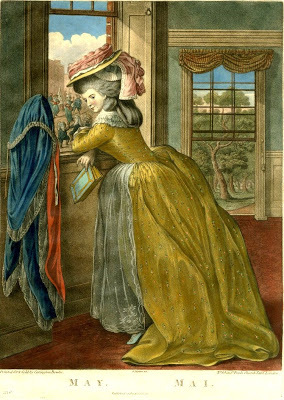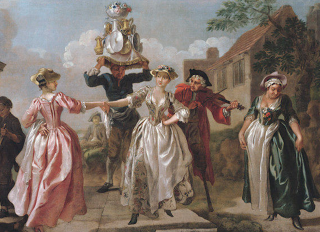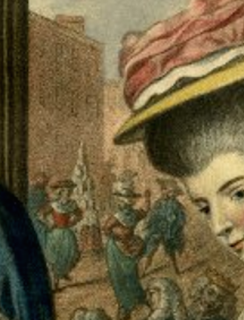What to Learn from Miss May, 1781
 Isabella reporting,
Isabella reporting,Last month Loretta and I had the pleasure of speaking at the annual conference of the New England Chapter of Romance Writers of America. Ostensibly our topic was busting a few historical myths that turn up all too often in historical romances, but because it was us and we like to talk, we made several other points about research as well. Two of our favorites: popular prints can be great sources of historical information, and, conversely, don't take everything you see (or read) at face value.
This print, right, would've made a perfect example. Pretty young women seem to have always been used to illustrate the calendar months, and this lady coyly glancing over her shoulder represents May, 1781. She's one of a set of twelve prints that could have been purchased together or individually. Hand-colored prints like this were increasingly popular in the 18thc, whether framed or simply pinned to the wall, where they added a touch of fashionable gentility in homes and businesses that couldn't necessarily afford paintings.
Miss May is dressed so elegantly and so on-trend that she could almost be considered a fashion plate. Strewn with woven flowers, her silk dress was called an Italian gown, with a close-fitting bodice, long narrow sleeves, and a great deal of fullness in the back. Open in the front, the gown would have been worn over a matching petticoat. She's also wearing a sheer embroidered apron that's purely decorative, as well as a ruffled kerchief. Her silk-trimmed straw hat is tipped forward over a pleated cap, and hanging beside her is her hooded cloak, also trimmed with lace.
So what about her appearance and attire is a faithful representation of women's dress in 1781, and what's exaggerated? It's safe to say that her tiny little foot in its tiny little shoe wasn't really that tiny; surviving shoes from the period prove that English women's feet were in proportion to the rest of them. Her dramatic hairstyle was accurate (see our earlier posts here and here on 18thc big hair), but to make her hair and hat more stylishly impressive by comparison, the artist seems to have shrunk her face. And that ample posterior? That, perhaps surprisingly, is accurate, and would have been achieved with the help of a false bum or rump - pillow-like enhancements that were tied around the waist to support the skirts and give a come-hither wiggle to the walk. (See more about false bums here.)

But there are other things to learn from this print, too. Because it's May and spring is here, the lady has not only put aside her cloak, but opened the windows in her house, too. Of course those windows have no screens; wire screens don't become affordable and widely used until the 19thc, and even then they're much more common in America than in Europe (they still are.) The window behind the lady appears to be tall enough to be used as a doorway when raised, leading to a path through the park.
There's also another indication that May has arrived. The scene in the street that the lady is watching is a May Day (the first of May) celebration called the "Milkmaid's Garland", which is also illustrated in the painting, right. To quote the Victoria & Albert Museum's caption:

"One of the ancient customs observed on May Day that persisted until the early 19thc was the 'Milkmaid's Garland.' The milkmaids would dress in their best clothes and dance in the streets for their customers. A donation from the customers and from passers-by was expected. A 'garland' - a pyramid of borrowed silver tankards, plates, and flagons decorated with flowers - was paraded by the milkmaids or carried, as in this painting, by a porter."
I'm sure that the grotesque figures also dancing in the street - probably with oversized masks - have something to do with an 18thc May Day as well, but I haven't discovered exactly what. Does anyone among our scholarly readers have the answer?
Left: May/The Twelve Months, published by Carrington Bowles after Robert Dighton, London, 1781. The British Museum.
Right: Detail, The Milkmaid's Garland, or the Humours of May Day, by Francis Hayman, 1741-1742, Victoria & Albert Museum.
Published on May 23, 2016 18:16
No comments have been added yet.



